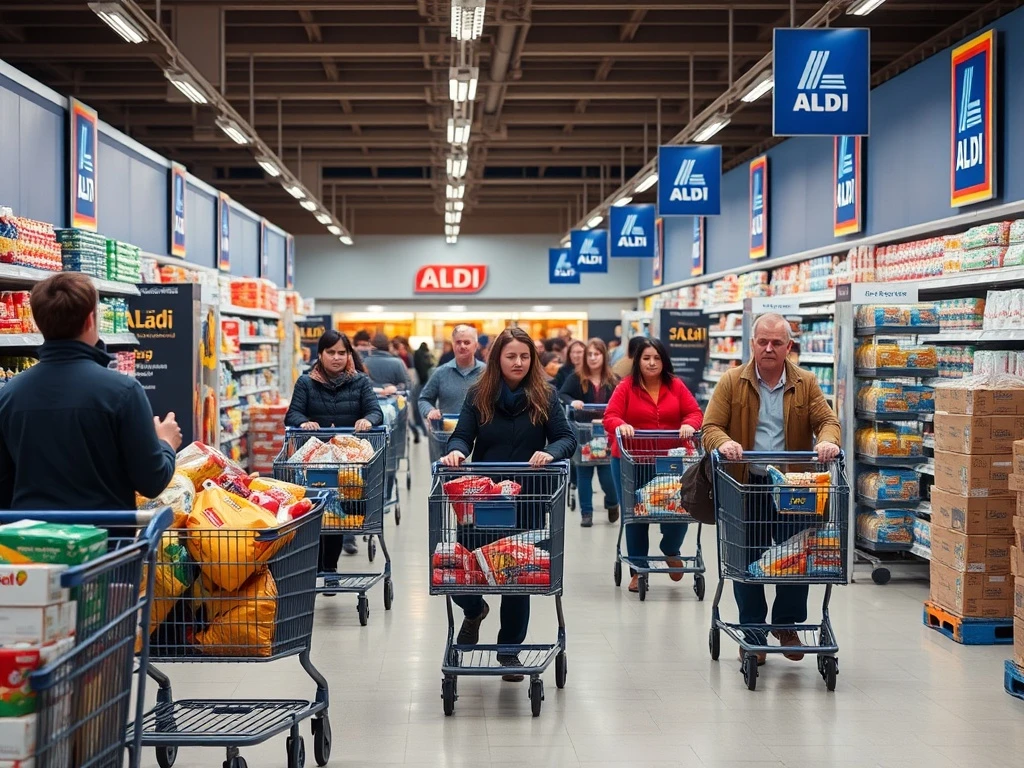American shoppers are flocking to Aldi in unprecedented numbers, transforming the German discount chain into the nation’s fastest-growing supermarket as inflation continues reshaping consumer behavior. Surprisingly, queues for new product releases now rival those for sneaker drops and tech launches at Aldi locations nationwide.
Aldi’s Remarkable Expansion Strategy
The German retailer has achieved extraordinary growth through strategic expansion. Consequently, Aldi has doubled its US footprint since 2014. Currently operating over 2,500 stores across 40 states, the company plans aggressive expansion. Specifically, Aldi will open 225 new stores in 2025 alone. Moreover, an additional 800 locations are planned by 2028. This expansion will bring their total US presence to over 3,200 outlets.
Consumer Response and Cultural Impact
American consumers have embraced Aldi with remarkable enthusiasm. Between 2019 and 2024, grocery footfall increased 51% at Aldi locations. This significantly outpaced the industry average of 11%. Last year, Aldi stores attracted 924 million visits. Consequently, it became America’s third-most visited supermarket after Kroger and Publix.
Shoppers particularly appreciate Aldi’s unique approach:
- Limited product selection (around 2,000 items vs. 30,000+ at conventional supermarkets)
- 90% own-brand products free from artificial dyes and additives
- Cost-saving operations that translate to lower prices
Economic Factors Driving Aldi’s Success
Several economic factors contribute to Aldi’s position as the fastest-growing supermarket. US food prices rose nearly 24% between 2019-2024. This inflation pushed budget-conscious shoppers toward discount options. Additionally, potential trade policies create ongoing economic uncertainty. Therefore, consumers continue seeking value-oriented shopping solutions.
A recent AARP study confirmed Aldi’s price advantage. A typical shopping basket costs approximately $66.11 at Aldi. This represents about 20% savings compared to Target. Furthermore, Aldi recently implemented summer price cuts on over 400 items.
Read Also: Shoplifting Prevention: Supermarket Rival Unveils Innovative Strategy to Combat Theft
Community Building and Social Media Influence
Aldi has cultivated an impressive community following. Dedicated influencers and social media groups drive engagement significantly. For example, the ‘Aldi Nerd’ Facebook group boasts 1.4 million members. Similarly, Instagram accounts like ‘Oh Hey Aldi’ have gained 173,000 followers. These communities share new product alerts and shopping tips. Consequently, they create excitement around limited-edition items.
Ashley Williams, an Illinois mother of four, explains the phenomenon: “There’ll be such a line that they give out tickets. We’re in the Midwest, and it’s pretty cold in the fall, but people still turn out.”
The Future of Aldi in America
Aldi’s growth trajectory shows no signs of slowing. The retailer’s no-frills model continues resonating with American shoppers. Additionally, their commitment to quality private-label products builds trust. As economic uncertainties persist, value-focused shopping remains paramount. Therefore, Aldi’s position as America’s fastest-growing supermarket appears secure.
James Cook, senior director of US retail research at JLL, summarizes the situation: “In our modern supermarket era, I haven’t seen anything like this.” Dave Rinaldo, Aldi’s US chief operating officer, adds: “We literally can’t open the stores fast enough.”
Frequently Asked Questions
How many stores does Aldi currently operate in the US?
Aldi currently operates more than 2,500 stores across 40 states, with plans to expand to over 3,200 locations by 2028.
Why is Aldi considered the fastest-growing supermarket?
Aldi’s foot traffic surged 51% between 2019-2024 while the industry average was only 11%, and they’re expanding at twice the pace of competitors.
What makes Aldi’s pricing strategy different?
Aldi saves costs through smaller stores, limited product selection, and mostly own-brand products, allowing them to offer prices approximately 20% lower than competitors.
How does Aldi maintain quality with lower prices?
Aldi’s extensive private-label products are often free from artificial dyes and additives, and their efficient operations reduce overhead costs without sacrificing quality.
What social media communities follow Aldi?
Major communities include the Aldi Nerd Facebook group with 1.4 million members and Instagram accounts like Oh Hey Aldi with 173,000 followers.
Are Aldi’s expansion plans continuing despite economic changes?
Yes, Aldi plans to open 225 new stores in 2025 and 800 additional locations by 2028, indicating strong continued growth commitment.








